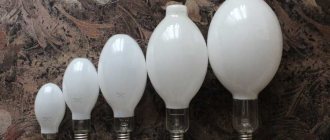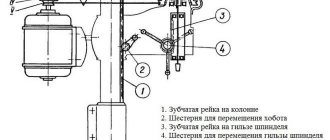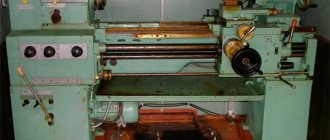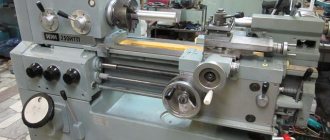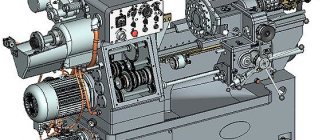The popularity of new models of light sources is explained by the need to reduce the consumption of energy resources. Energy-saving lamps are used in everyday life and are suitable for lighting the street, production workshop, educational and medical institutions. The efficiency of the mercury tungsten arc (mercury-mercury) lamp is ensured by the hybrid design of the light-emitting elements and the e40 base, which is compatible with mounts for conventional incandescent lamps.
What it is
MRV bulbs stand for mercury tungsten arc bulbs, they are very famous among buyers. They are made in the largest industrial factories.
Size options
It is difficult for inexperienced people to visually distinguish DVR and DRL bulbs. The differences lie in their technical features. In the design of these light bulbs you can see:
- Base. A part that receives electricity from the network due to the connection of the contacts of the socket and the light bulb;
- Quartz vessel. It must be filled with argon combined with a drop of mercury, and has two main and two auxiliary electrodes. Will act as a burner;
- Glass vessel. It will act as a container in which the quartz vessel and base are placed. The inside of the flask is coated with a phosphor and nitrogen is poured into it.
Note! A tungsten spiral is placed inside a tungsten light bulb along with a quartz vessel. It will act as a current-limiting part.
The increased popularity of mercury arc lamps is explained by the cost-effectiveness of their use. I use exactly these lamps in various new lamps or floor lamps. You can save money and not spend it on:
- purchasing the latest and most expensive lighting fixtures;
- installation of brackets;
- carrying out a new wiring.
Safety regulations
When using a lamp, you must follow some safety rules:
- Before installing the light bulb, you need to carefully unpack it and make sure there are no mechanical damages;
- It is prohibited to screw in or operate a faulty lamp; you also cannot use an open lamp in an open place where it is not protected from wind or precipitation;
- After installation, it is necessary to carry out a test by turning on the lamp for 10-15 minutes. After that it can be used. It is important to remember that DRV lamps take several minutes to light up;
Important! If the network voltage is higher than 220 V, the lamps will fail faster and their service life will end earlier.
- Any installation of the lamp must be carried out only with the electricity turned off;
- If the light bulb becomes dirty, wipe it with a dry soft cloth. Solvents or aggressive cleaning agents must not be used;
- The lamp can be placed in any position - both horizontally and vertically;
- Light bulbs should be stored in packaging, not dropped or broken, they should not be given to children or allowed to play with;
- It is necessary to dispose of lamps by handing them over to a collection point for mercury lamps.
If the light bulb does break, you must:
- Ventilate the room for at least 30 minutes, after leaving it;
- Wear disposable gloves and sweep all large parts into a bag using paper or cardboard;
- Use a wet sponge or tape to collect small pieces. Mercury must be collected moving from the edges to the center;
- At the very end, clean using chlorine.
DRV and DRL light bulbs are often used to illuminate streets, warehouses, workshops and construction sites. They are easy to install and use, easy to install and change, and provide good quality light. However, both lamps are classified as hazard class 1 due to their mercury content and should be used with caution.
- In stock
- Wholesale
- 25.11.19
Experienced employees are always happy to provide consultation and help you in choosing materials, equipment and tools. If necessary, we can train a representative of your company to work with the purchased equipment!
- In stock
- Wholesale
- 05.11.19
We offer integration and maintenance of internal engineering systems, networks and communications for private country houses, cottages, apartments, offices, restaurants and other facilities in Moscow and the Moscow region and regions.
- In stock
- Wholesale
- 24.11.19
- In stock
- Wholesale
- 25.11.19
They are universal, suitable for external and internal lighting of construction sites, gardens, road structures and industrial facilities. With good lighting parameters, mercury lamps have a long service life and reliability.
- In stock
- Wholesale
- 25.11.19
They are universal, suitable for indoor and outdoor lighting of construction sites, industrial facilities and road structures, gardens. With good lighting parameters, mercury lamps are reliable and have a long service life.
- In stock
- Wholesale
- 25.11.19
They are universal, suitable for external and internal lighting of construction sites, gardens, road structures and industrial facilities. With good lighting parameters, mercury lamps are reliable and have a long service life.
Advantages and disadvantages
The main disadvantages of these light bulbs:
- Reduced light transmission;
- They have a short service life, about 3000 hours, so they are not profitable to buy for street lighting;
- Small selection of models (lamp 160 W, 700, 1000).
Types of socles
Advantages of DRV:
- low price;
- convenience;
- easy to connect to the network;
- ignite instantly;
- equipped with operability from different sources of electricity and over a fairly wide voltage range;
- The light is always stable, even at low voltage.
Alternative lighting sources
An energy-saving LED lamp is an excellent analogue to other lighting sources, including DRL; if you buy it, you can significantly save on electricity. Replacing street lighting will pay for itself after three years of operation, even taking into account the refurbishment work.
Many well-known foreign and Russian companies (for example, Lisma) are engaged in the production of these lighting devices. Currently, the price of these devices is slightly higher than the cost of a DRL lamp, but in the near future this problem will be eliminated, which will make LED lighting sources more accessible in Moscow, St. Petersburg, as well as in cities such as Saransk or Yekaterinburg.
Characteristics
As an example, we will consider the technical characteristics of the lamp drv 250:
- the indicated power level will be 250 W;
- the voltage on the light bulb is approximately 220 W;
- luminous flux indicators of 4800 lm;
- light output about 18.9 lm/W;
- model E40 base;
- the lamp diameter will be 90 mm;
- product length 230 mm;
- continuous operation up to 3500 hours.
DRV 700 main characteristics. Designed mainly for street lighting, it has an E40 model base. Operating life up to 20,000 hours, product length 358 mm, diameter 150 mm.
Note! Lamp drv GOST No. R 53074-2008 contains test methods and markings for mercury products. It specifies the requirements for luminous flux and stable operation of lamps.
What does the burner look like?
Technical aspects
The most important indicators of a mercury light source with an e40 base are the design of the internal part of the device, the shape of the bulb, and the dimensions of the threaded base. The economic effect of the device may differ in operating conditions. The gas-discharge soffit from the Lisma brand for street lighting, which does not create a flickering effect in the event of voltage surges in the electrical network, does not require a special device for igniting the arc. At a power of 500 W, a luminous flux of 4 - 5 thousand lm is created.
Characteristics:
- Name - DRV lamp;
- Type - mercury;
- Power - 500 V;
- Shape - ellipse;
- Manufacturer - ;
- Purpose - street;
- The flask coating is matte;
- Base - e40.
When marking energy-saving appliances, digital and letter values are used to indicate the power and type of product. It is not difficult to decipher these meanings. Examples:
- DRL 250 - arc mercury phosphor lamp with a power of 250 V;
- DRV 160 is a mercury-tungsten arc lamp with a power of 160 V.
The source of an even luminous flux DRV 500, the characteristics of which are determined by the parameters of the base, can have a mixed type design. The starter circuit may contain a choke. The ballast serves to reduce the voltage on the electrodes by increasing the voltage in the active luminescent device. The device is made in the form of a coil with a wire wound around a ferromagnetic core. To reduce reactive energy in the E40 lamp circuit, it is enough to disconnect the compensating capacitor.
The technical characteristics of the device are adapted for open spaces. The DRV 500 lamp demonstrates excellent results at a voltage of 220 V with a current oscillation frequency of 50 Hz. The devices are designed for continuous operation for 7.5 thousand hours.
Operating principle
Any burner is made from a light, refractory composition that is resistant to various influences. Ceramic additives or quartz glass are used for it. The nitrogen that is added inside has an exact weight. At the end, a little mercury is added to make the glow brighter and longer.
You might be interested in Energy-saving lamps: recommendations for choosing
Starting is done using ignition electrodes. When energy is supplied to the product, a smoldering charge appears between the ignition and main elements, which are located quite close to each other. The result is an accumulation of discharge carriers sufficient to form a breakdown at the distance between the two main electrodes. The smoldering charge instantly takes on an arc form.
DRV device design
Design
In terms of device, the DRV lamp is very similar to a charging mercury burner, as in products of the DRL model. Its design is as follows: the sucking device is equipped with a tungsten spiral. It is located in an argon substance in the outer flask. The spiral will act as a current-limiting component for the burner.
Because of this design, a device of this type is not equipped with an external ballast and can be used in lamps instead of traditional incandescent light bulbs.
Burner
As the burner heats up, its voltage increases to approximately 70 V, and on the coil itself it begins to decrease. The burner is secured with additional clamps that rest against the vessel.
Inner spiral
Spiral
In addition to the burner, the vessel of the device contains a special tungsten spiral. For the burner it will act as a current limiter.
Base
The lamp base is necessary for:
- product operation. There is a contact in the base that, when connected, begins to work, that is, turn on the light;
- easy replacement of the lamp in case of burnout or breakage.
Principle of operation
The operating principle of gas-discharge lamps is a little more complicated than that of incandescent light bulbs.
- When current is applied, voltage is transmitted to the current-carrying parts of the base;
- Then the energy passes through the circuit to the electrodes located in the burner, and a glow discharge appears between them. Ions and free electrons begin to accumulate on the surface;
- As ions and electrons accumulate, the internal space of the burner begins to heat up, and the mercury evaporates. The discharge occurs from a glowing state to an arc state, which creates blue or violet radiation;
- This glow causes the phosphor to glow, which creates a reddish light. When all colors are mixed, the result is white.
The more mercury vapor evaporates, the more the brightness of the discharge increases. On average, it takes 4-5 minutes for the DRL to light up, while the DRL lights up almost immediately.
Important! The higher the air temperature, the less time it will take.
Application area
These types of light bulbs can be found in almost every room. Where are DRLs mainly used:
- street lighting;
- the shops;
- covered parking lots;
- factories and workshops.
Where DRV products are used:
- city districts;
- public places;
- plant and workshops;
- car parking;
- in construction work;
- flowers in greenhouses.
E40 socket for 250 W
These light bulbs are manufactured with a power from 200 to 1000 W. Sometimes you can see 90 and 125 W DRL lamps on sale. A 1000 W product can reach 45,000 lumens.
Less powerful products are manufactured with E40 cartridge. Therefore, they can be inserted even into old chandeliers and floor lamps. Large light bulbs are made with E27 socket. Mainly used for street lighting.
Device types
Lamps operating according to the principle described above are of the following types:
FRL – fluorescent mercury arc lamp;
Model HPL-N (Philips)
DRL lamps differ from DRL lamps in that they use a tungsten filament, which performs two functions: a light source and an electric current voltage limiter. To operate a device of this type, no special ballasts are required (throttleless electric lamp);
High pressure DRV devices (HQL), manufacturers Osram and Philips
DRLF – light sources that promote the process of photosynthesis in plants;
DRLF type device
DRUF and DRUFZ - emit in the long-wave ultraviolet spectrum;
Ultraviolet (bactericidal) electric lamp
DRT – tube-type ultraviolet light source;
Lighting source DRT
HPS - tubular lamps, in which, unlike DRL, in addition to mercury, sodium vapor is also used. The main feature is a specific shade of radiation (orange-yellow or golden-white), which requires special equipment to launch.
Mercury-sodium lamp DNAT
How to connect correctly
In order for the product to operate smoothly, the correct connection system for this device is necessary. If the installation was carried out correctly, then lighting such a light bulb will not be difficult and there will be no defects during operation.
The connection diagram is quite simple and is similar to the circuit of a systematically connected inductor and the DRL lamp itself.
Simple connection diagram
You need to connect it to a 220 volt network, it will operate at the classic frequency. Therefore, they can be connected in a house or apartment without any problems. The throttle provides adjustments to the operation. The throttle makes sure that the light does not flicker or turn off and works evenly.
You may be interested in this Features of the E27 base
